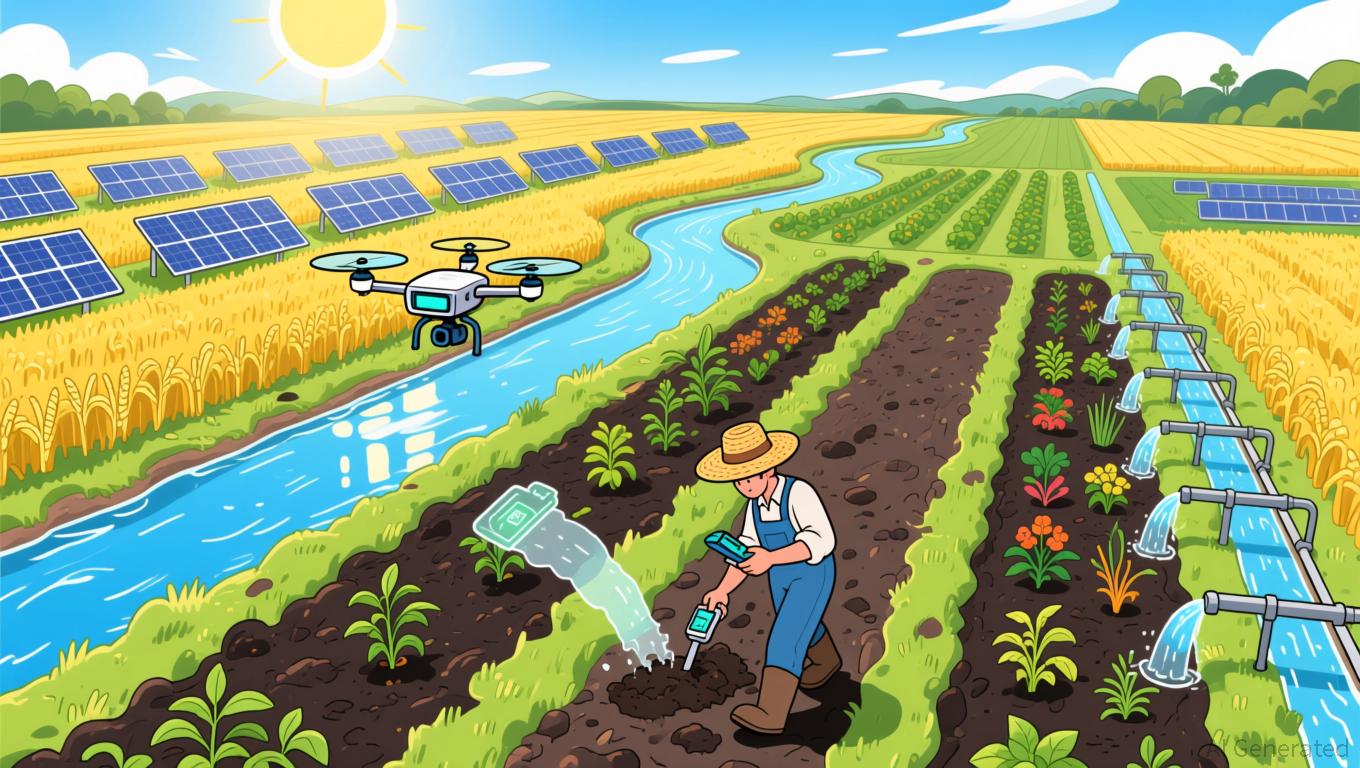Farmers Struggle for Water Amid the Growth of AI Data Centers
- AI infrastructure's rising energy and water demands clash with agriculture's resource needs, straining global grids and water supplies. - U.S. farmers face higher costs as data centers drive up electricity prices and deplete water in drought-prone regions. - Initiatives like Honda's regenerative agriculture program and autonomous farming robots aim to mitigate resource conflicts through sustainability. - Policy responses, including U.S. farm relief plans and COP30 climate negotiations, highlight agricult
The increasing consumption of electricity and water by artificial intelligence (AI) infrastructure is causing concern within the agricultural industry, as resources traditionally dedicated to farming are now being diverted to power-hungry data centers. Although AI is often touted for its future potential to enhance productivity, immediate pressures on power grids and water reserves are already sparking demands for regulatory action and sustainable solutions to ensure that technological progress does not undermine food security.
The environmental impact of AI is drawing significant attention, with data centers—currently responsible for 2% of the world’s electricity use—expanding rapidly to satisfy growing computational needs. In China, the rapid development of AI-focused “smart computing centers” has resulted in an excess of largely idle facilities, many of which draw substantial energy while operating far below capacity. This phenomenon is reflected globally, as data centers contribute to rising electricity costs in places like the U.S. and Europe, putting additional financial strain on energy-reliant sectors such as agriculture. At the same time, the heavy water usage required for cooling these centers further depletes local water resources, a challenge that is particularly severe in drought-affected agricultural regions.
The conflict between AI’s appetite for resources and the requirements of agriculture is especially pronounced in the United States, where farmers are contending with reduced water availability and escalating energy expenses. Honda’s recent partnership with the Carbon by Indigo initiative to promote regenerative farming practices is one example of efforts to ease these challenges. By investing in soil health and water-saving methods across 214,000 acres, the company seeks to strengthen resilience against resource shortages while also cutting carbon emissions.

Market forces are also evolving in response to these issues. The autonomous agriculture robot market,
Governments are beginning to respond with policy measures.
The conversation about AI’s environmental effects extends beyond just energy and water.
As AI’s reach grows, there is a growing recognition among stakeholders of the need for cooperation. “Remember, we still need to produce food,” industry leaders caution, stressing that advances in AI should not jeopardize the stability of agriculture. With both data centers and farms competing for limited resources, future solutions will depend on innovations that maximize efficiency and policies that ensure fair allocation.
Disclaimer: The content of this article solely reflects the author's opinion and does not represent the platform in any capacity. This article is not intended to serve as a reference for making investment decisions.
You may also like
MMT Token Experiences Dramatic Fluctuations Amid Shifting Blockchain Regulations and Changing Investor Trends
- Melania Meme Token (MMT) surged to $13.73 in 2025 before collapsing 99% to $0.1004, exposing risks of speculative memecoins. - Centralized control (89% supply in one wallet) and a fraud lawsuit triggered trust erosion amid regulatory scrutiny. - Contrasting XRP ETF launches and Ripple's $500M raise highlighted institutional preference for compliant, transparent tokens. - FOMO-driven retail frenzy and social media sentiment amplified MMT's volatility, underscoring crypto's psychological dynamics. - The ca
Solana News Update: SEC's Crypto ETF Disagreement: Bitcoin Sees $1.6B Outflow, Solana Attracts $26M
- SEC's regulatory decisions drive divergent crypto ETF flows: Bitcoin ETFs lost $1.6B while Solana ETFs gained $26.2M in November 2025. - Traditional firms like Qualigen (now AIxCrypto) and Coincheck pivot to blockchain, signaling growing institutional adoption of decentralized technologies. - South Korea's Dunamu saw 300% Q3 profit growth linked to U.S. crypto regulatory progress, while Harvard invested $442M in Bitcoin ETFs. - SEC's focus on utility-driven crypto projects may accelerate ETF approvals fo
Hyperliquid News Today: Phantom Brings Chains Together, Simplifying Crypto with HyperEVM
- Phantom Wallet integrates Hyperliquid's HyperEVM blockchain, enhancing cross-chain interoperability for crypto users. - Users can now manage HyperEVM assets, trade, and access liquidity directly within Phantom, reducing multi-wallet complexity. - Hyperliquid's $10.6B market cap and high-performance trading features position it as a key player in decentralized derivatives markets. - The integration aligns with industry trends toward simplifying multi-chain interactions, potentially accelerating mainstream

Bitcoin Updates: Turning Point or Opportunity? Recent STH Bitcoin Sales Signal Upcoming Bull Market Rebound
- Bitcoin's recent price drop below $100,000 triggered mass capitulation as short-term holders (STHs) dumped 148,000 BTC at a loss in 48 hours. - Institutional outflows worsened the sell-off, with $866.7M in Bitcoin ETF redemptions on Nov 13, led by Grayscale and BlackRock . - Long-term holders sold 815,000 BTC since Jan 2024, but whale wallets absorbed 45,000 BTC weekly, signaling potential market rebalancing. - Technical indicators show Bitcoin testing $94,000 support, with STH selling risks pushing pric
